Synthesis and Characterization of Molecularly Imprinted Polymer Membrane for the Removal of 2,4-Dinitrophenol
Abstract
:1. Introduction
2. Results and Discussion
2.1. Characterization of CA-MIP and PS-MIP Membranes
2.1.1. Fourier Transform Infrared Spectroscopy (FTIR) Spectra of CA-MIP and PS-MIP
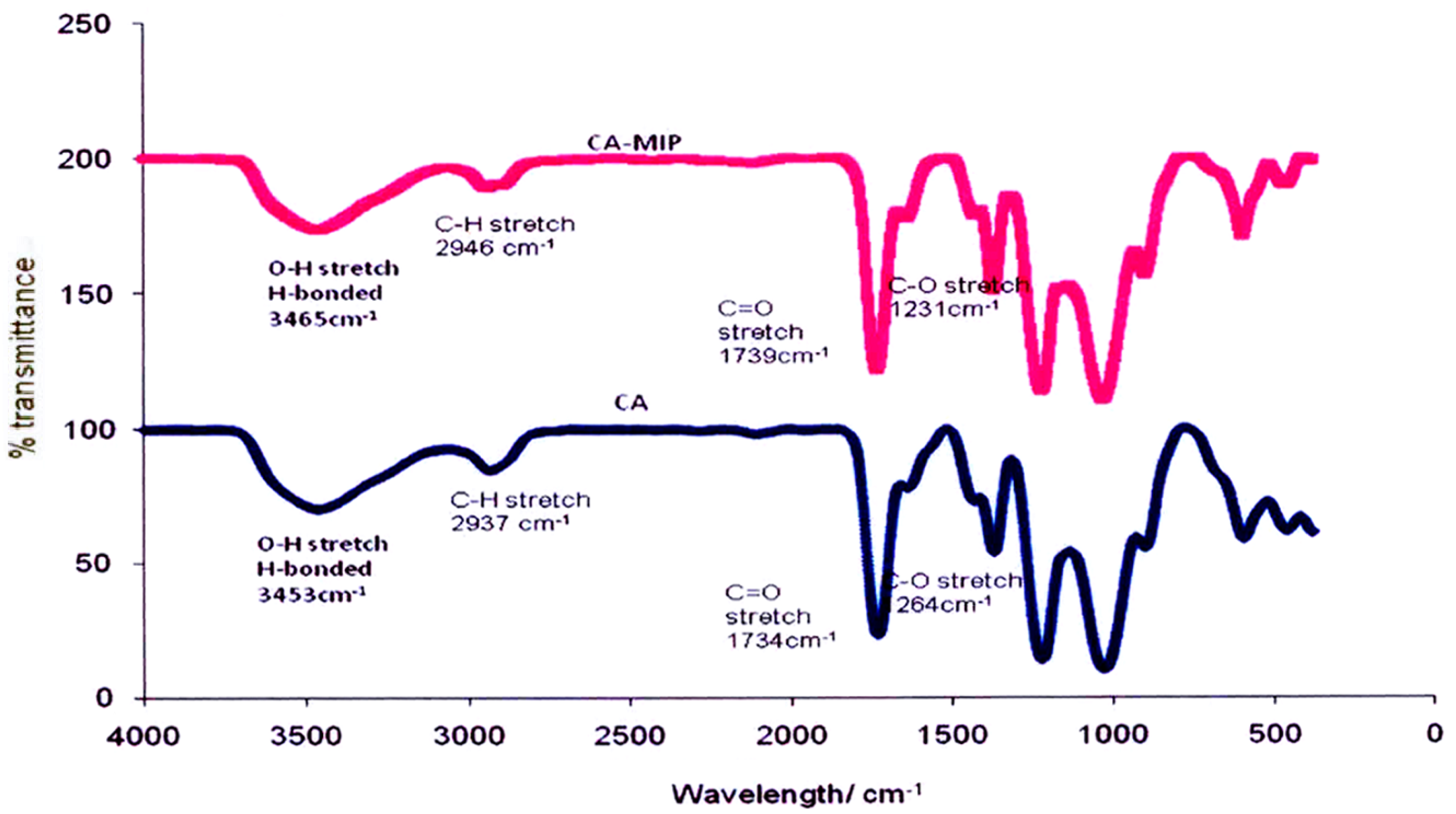
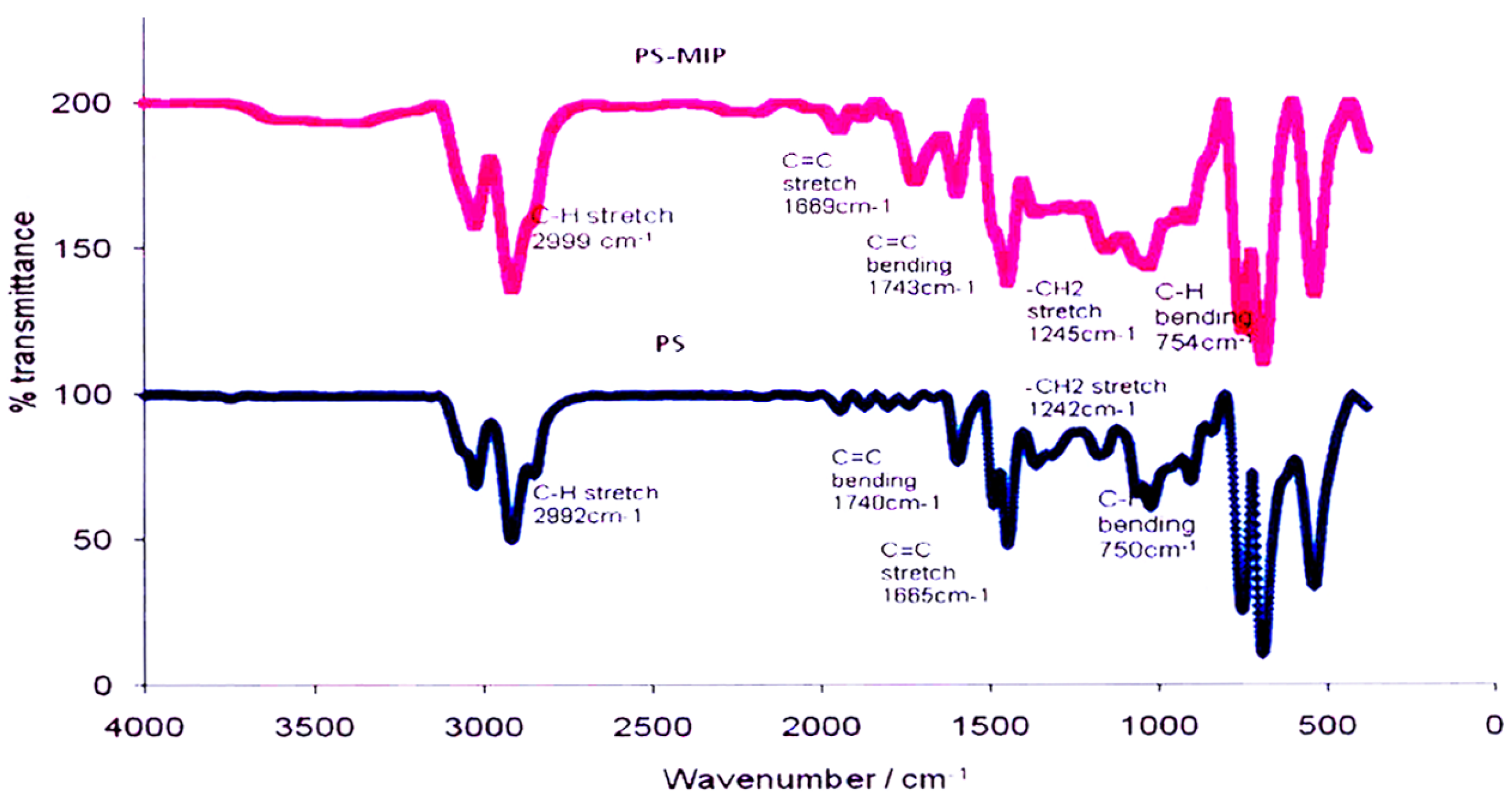
2.1.2. Scanning Electron Microscopy (SEM) Images of CA-MIP and PS-MIP
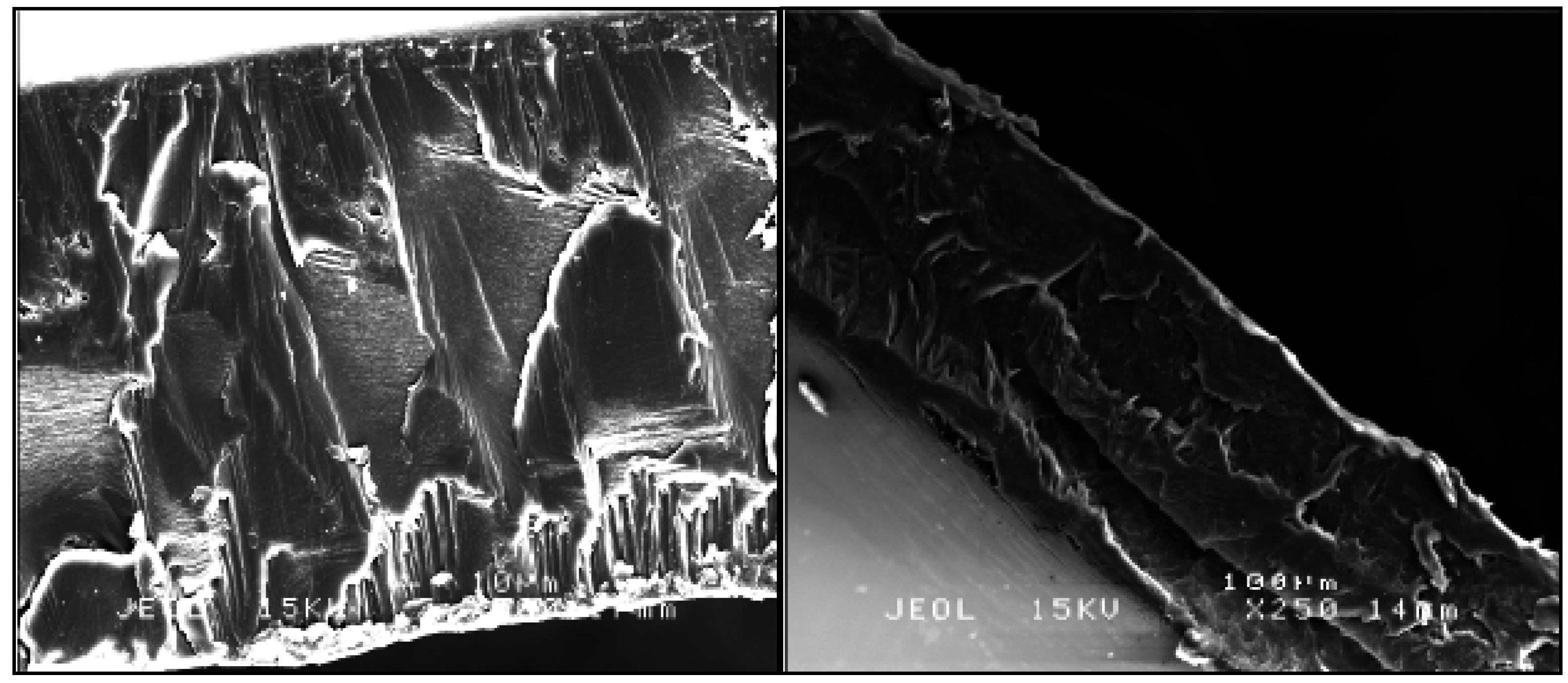
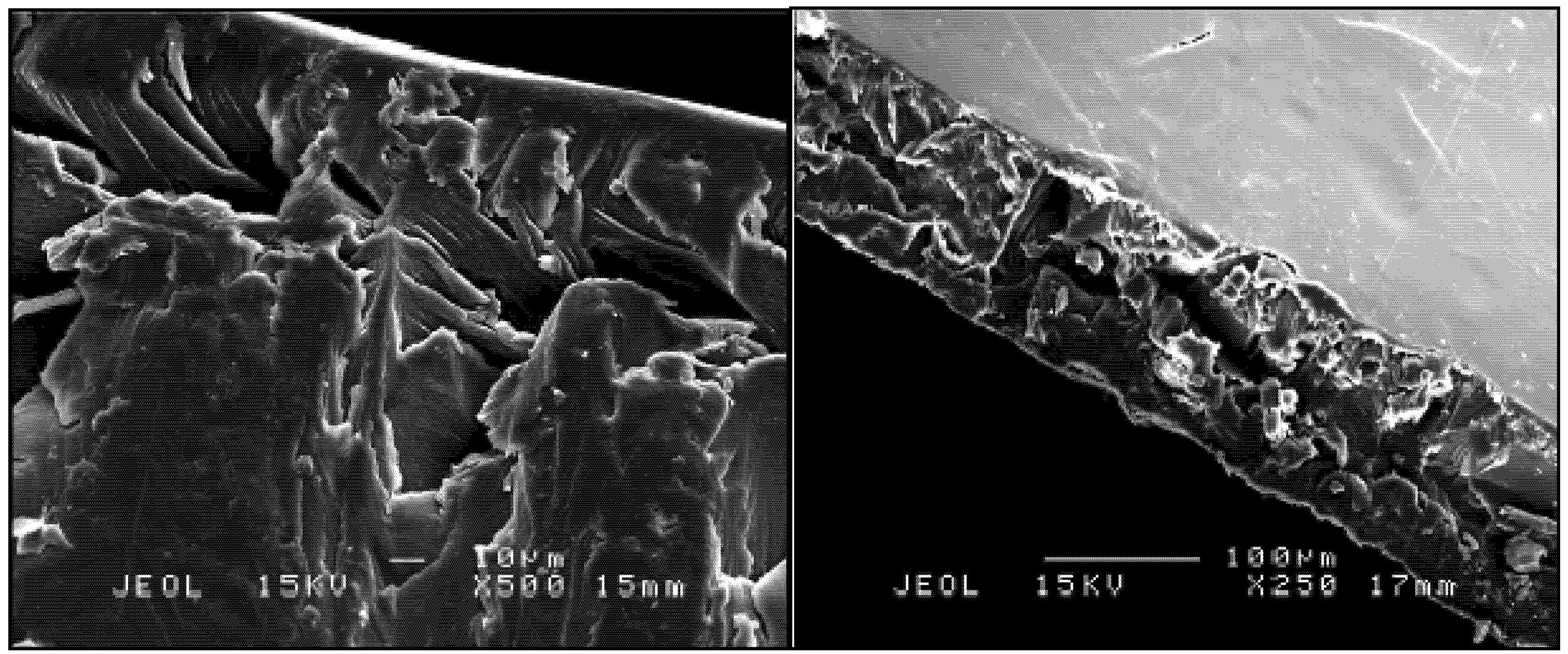
2.2. Sorption of 2,4-DNP by CA-MIP and PS-MIP
2.2.1. Effect of pH
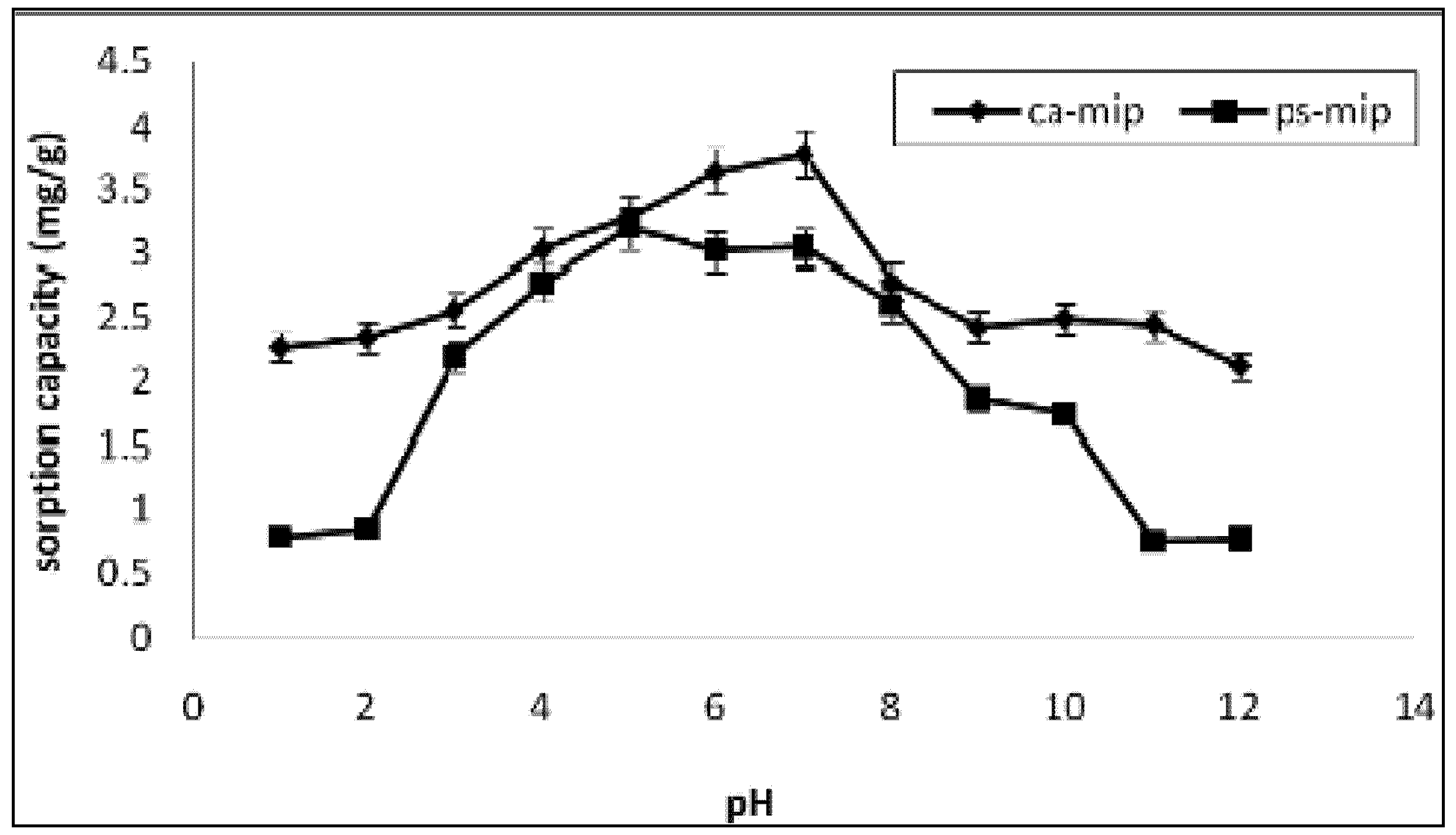
2.2.2. Kinetics of the Sorption of 2,4-DNP by MIP and a MIP Membrane
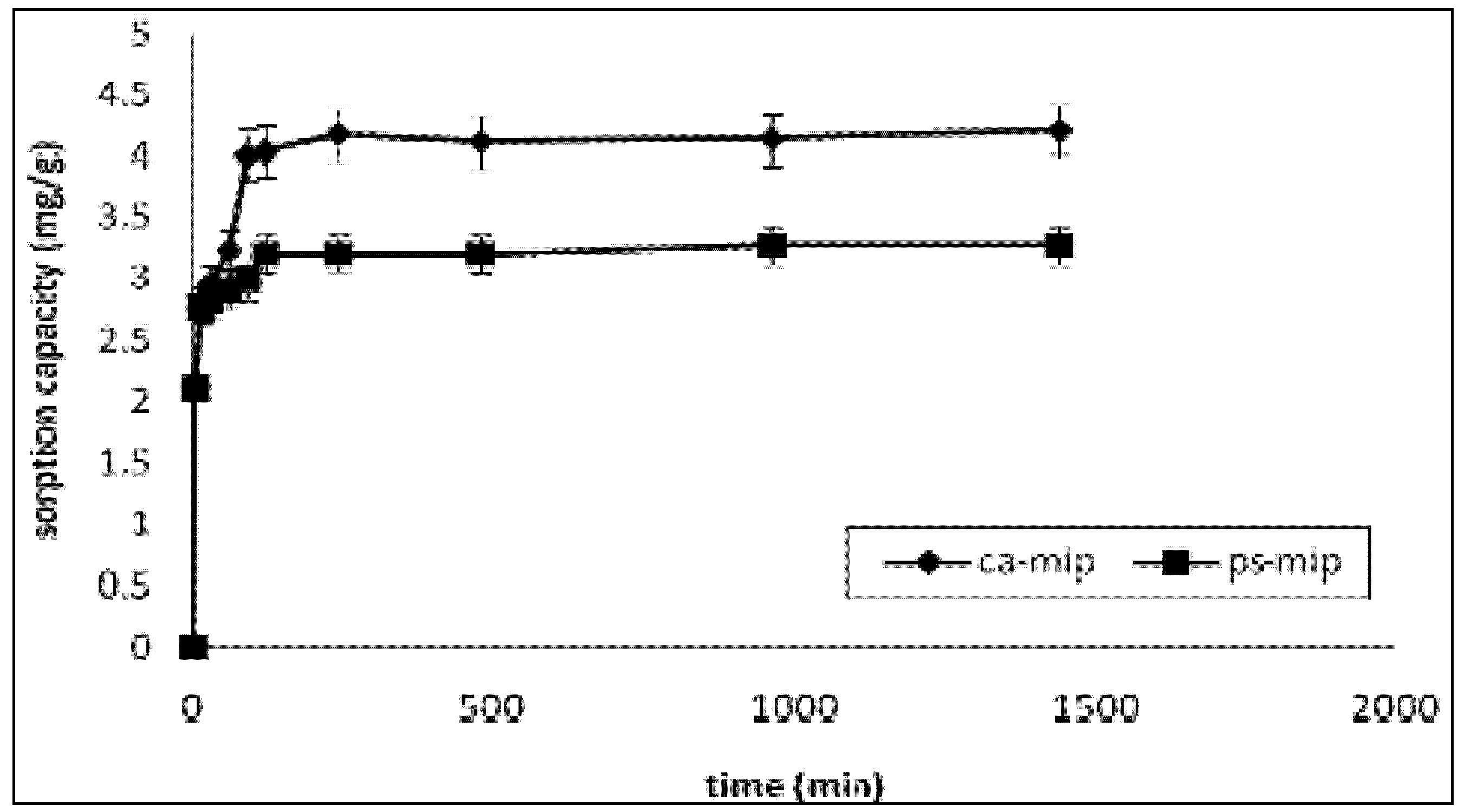
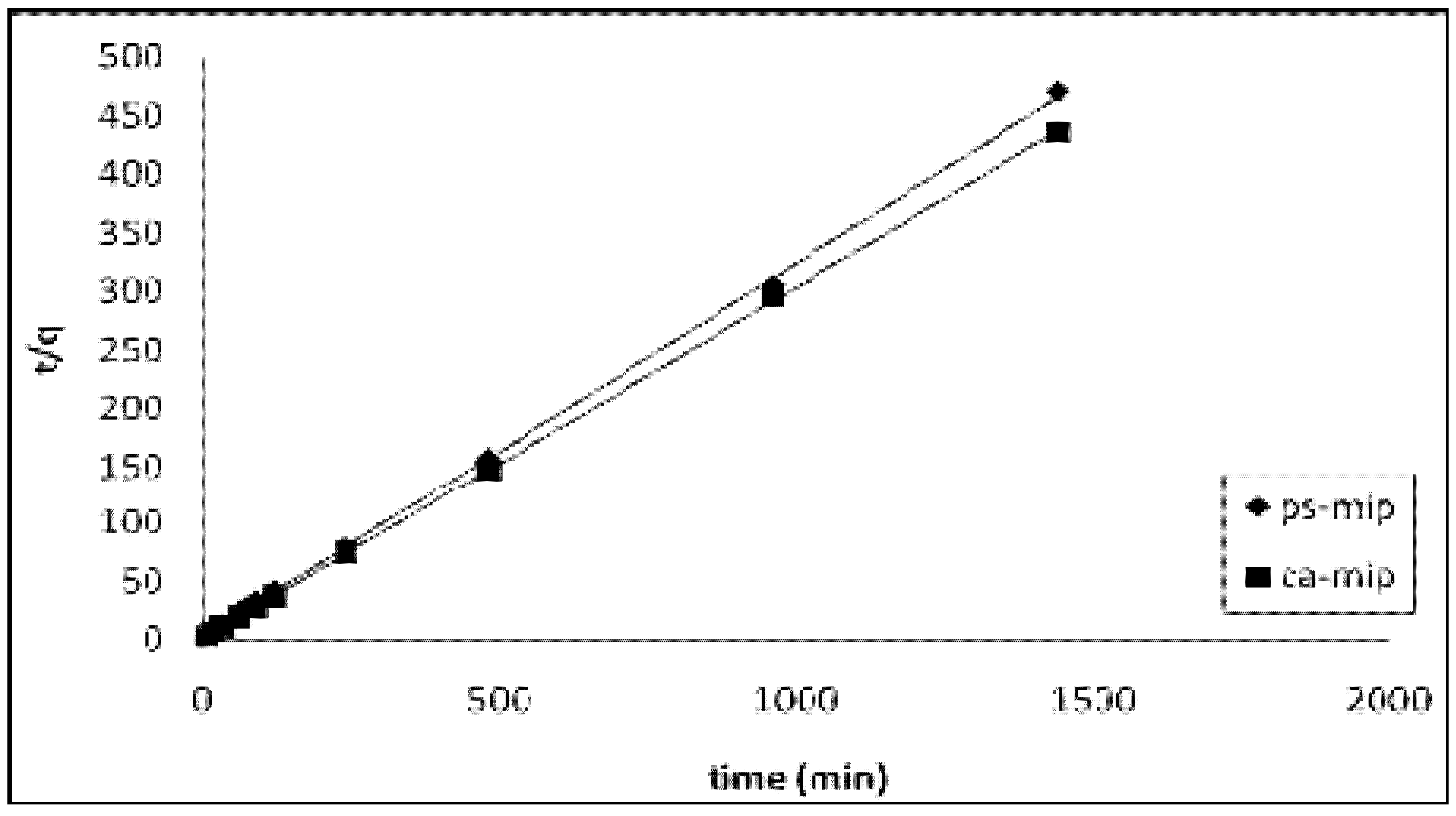
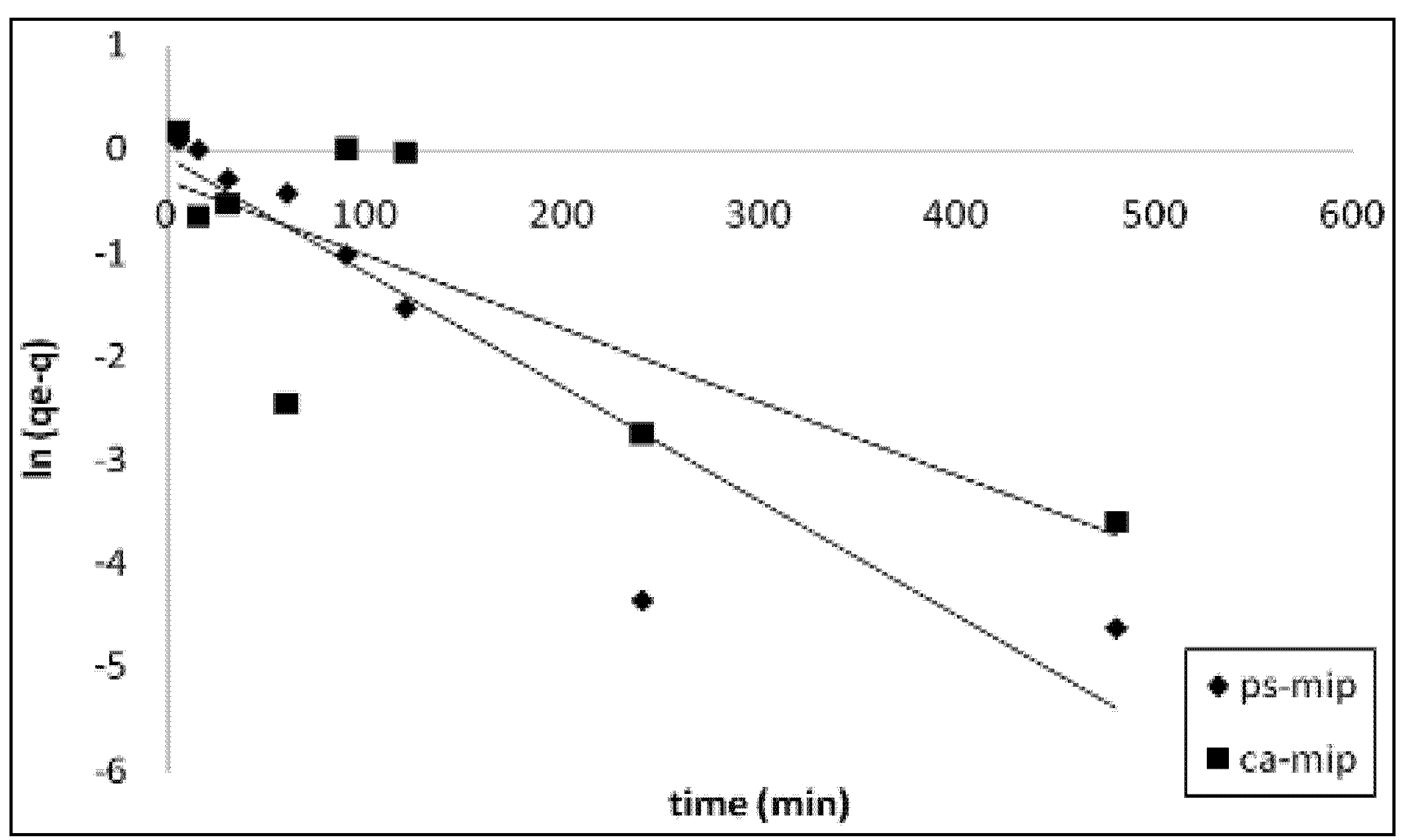
| Kinetic model parameter | Sorbent | ||
|---|---|---|---|
| CA-MIP | PS-MIP | ||
| First-order | k1(min−1) | 0.233 ± 0.01 | 0.145 ± 0.01 |
| qe (mg g−1) | 0.63 ± 0.1 | 0.84 ± 0.1 | |
| r2 | 0.602 | 0.864 | |
| Pseudo–second-order | k2 (g mg−1 min−1) | 0.370 ± 0.01 | 0.115 ± 0.01 |
| qe (mg g−1) | 3.30 ± 0.1 | 3.10 ± 0.1 | |
| r2 | 0.999 | 0.999 | |
2.2.3. Selectivity Study
| Kd(MIP) (mg/g) | Kd(NIP) (mg/g) | k(MIP) | k(NIP) | k' | |
|---|---|---|---|---|---|
| 2,4-DNP | 3.768 | 1.71 | |||
| Phenol | 1.493 | 1.946 | 2.534 | 0.878 | 2.88 |
| 3-CP | 1.548 | 1.728 | 2.431 | 0.989 | 2.46 |
| 2,4-DCP | 2.169 | 1.917 | 1.737 | 0.892 | 1.95 |

3. Experimental Section
3.1. Chemicals
3.2. Instruments
3.3. MIP Synthesis
3.4. Preparation of the MIP Membrane
3.5. Sorption of 2,4-DNP by the MIP Membrane
3.5.1. Effect of pH
3.5.2. Sorption Kinetics
3.5.3. Selectivity Study
4. Conclusions
Acknowledgments
References
- Li, Y.; Li, X.; Donga, C.; Li, Y.; Jin, P.; Qib, J. Selective recognition and removal of chlorophenols from aqueous solution using molecularly imprinted polymer prepared by reversible addition-fragmentation chain transfer polymerization. Biosens. Bioelectron. 2009, 25, 306–312. [Google Scholar] [CrossRef]
- Nyokong, E.M.T. Adsorption of 4-nitrophenol onto Amberlite® IRA-900 modified with metallophthalocyanines. J. Hazard. Mater. 2008, 15, 293–301. [Google Scholar]
- Navarroa, A.E.; Norma, A.C.; Jose, C.L.; Maria, R.S.K.; Bertha, P.L. Comparative study of the removal of phenolic compounds by biological and non-biological adsorbents. J. Hazard. Mater. 2009, 164, 1439–1446. [Google Scholar] [CrossRef]
- Erdem, M.; Erdinc, Y.; Turgay, T.; Yasemin, C.; Hayrettin, T. Synthesis of novel methacrylated based adsorbents and their sorptive properties towards p-nitrophenol from aqueous solutions. J. Colloid Interface Sci. 2009, 33, 40–48. [Google Scholar]
- Oh, C.G.; Ahn, J.H.; Ihm, S.K. Adsorptive removal of phenolic compounds by using hypercrosslinked polystyrenic beads with bimodal pore size distribution. Sep. Purif. Technol. 2004, 38, 173–179. [Google Scholar] [CrossRef]
- El-Hamshary, H.; El-Sigeny, S.; Manal, F.; Taleb, A.; El-Kelesh, N.A. Removal of phenolic compounds using (2-hydroxyethylmethscrylate/acrylamidopyridine) hydrogel prepared by gamma radiation. Sep. Purif. Technol. 2007, 57, 329–337. [Google Scholar] [CrossRef]
- Tomei, M.C.; Rossetti, S.; Annesini, M.C. Microbial and kinetic characterization of pure and mixed cultures aerobically degrading 4-nitrophenol. Chemosphere 2006, 63, 1801–1808. [Google Scholar] [CrossRef]
- Wu, Z.; Cong, Y.; Zhou, M.; Ye, Q.; Tan, T. Removal of phenolic compounds by electroassisted advanced process for wastewater purification. J. Chem. Eng. 2002, 19, 866–870. [Google Scholar]
- Luan, J.; Plaisier, A. Study on treatment of wastewater containing nitrophenol compounds by liquid membrane process. J. Membr. Sci. 2004, 229, 235–239. [Google Scholar] [CrossRef]
- Dai, R.; Jie, C.; Jie, L.; Shenyuan, X.; Shi, C.; Yulin, D. Reduction of nitro phenols using nitroreductase from E. coli in the presence of NADH. J. Hazard. Mater. 2009, 170, 141–143. [Google Scholar] [CrossRef]
- Zaggout, F.R.; Ghalwa, N.A. Removal of o-nitrophenol from water by electrochemical degradation using a lead oxide/titanium modified electrode. J. Environ. Manag. 2008, 86, 291–296. [Google Scholar] [CrossRef]
- Belaid, C.; Kallel, M.; Khadhraou, M.; Lalleve, G.; Elleuch, B.; Fauvarque, J.F. Electrochemical treatment of olive mill wastewaters: Removal of phenolic compounds and decolourization. J. Appl. Electrochem. 2006, 36, 1175–1182. [Google Scholar] [CrossRef]
- Ricardo, C.; Tarley, T.; Kubota, L.T. Molecularly-imprinted solid phase extraction of catechol from aqueous effluents for its selective determination by differential pulse voltammetry. Anal. Chim. Acta 2006, 548, 11–19. [Google Scholar]
- Guney, O.; Yilmaz, Y.; Pekcan, O. Metal ion template chemosensor for metal ions based on fluorescence quenching. Sens. Actuators B 2002, 85, 86–89. [Google Scholar] [CrossRef]
- Kataky, R.; Morgan, E. Potential of enzyme mimics in biomimetic sensors: A modified cyclodextrin as a dehydrogenase enzyme mimic. Biosens. Bioelectron. 2003, 18, 1407–1417. [Google Scholar] [CrossRef]
- Weiss, R.; Molinelli, A.; Jakusch, M.; Mizaikoff, B. Molecular imprinting and solid phase extraction of flavonoid compounds. Bioseparation 2001, 10, 379–387. [Google Scholar] [CrossRef]
- Walshe, M.; Garcia, E.; Howarth, J.M.; Smyth, R.; Kelly, M.T. Separation of the enantiomers of propranolol by incorporation of molecularly imprinted polymer particles as chiral selectors in capillary electrophoresis. Anal. Commun. 1997, 34, 119–122. [Google Scholar]
- Yang, G.; Liu, H.; Wang, M.; Liu, S.; Chen, Y. Chromatographic characterization and solid-phase extraction on diniconazole-imprinted polymers stationary phase. React. Funct. Polym. 2006, 66, 579–583. [Google Scholar] [CrossRef]
- Zhang, H.; Song, T.; Zong, F.; Chen, T.; Pan, C. Synthesis and characterization of molecularly imprinted polymers for phenoxyacetic acids. Int. J. Mol. Sci. 2008, 9, 98–106. [Google Scholar]
- Shim, Y.H.; Yilmaz, E.; Lavielle, S.; Haupt, K. Chiral recognition and separation of β2-amino acids using non-covalently molecularly imprinted polymers. Analyst 2004, 129, 1211–1215. [Google Scholar] [CrossRef]
- Glad, M.; Reinholdsson, P.; Mosbach, K. Molecularly imprinted composite polymers based on trimethylolpropane trimethacrylate (TRIM) particles for efficient enantiomeric separations. React. Polym. 1995, 25, 47–54. [Google Scholar] [CrossRef]
- Xia, Y.Q.; Guo, T.Y.; Song, M.D.; Zhang, B.H.; Zhang, B.L. Selective separation of quercetin by molecular imprinting using chitosan beads as functional matrix. React. Funct. Polym. 2006, 66, 1734–1740. [Google Scholar] [CrossRef]
- Li, X.; Husson, S.M. Adsorption of dansylated amino acids on molecularly imprinted surfaces: A surface plasmon resonance study. Biosens. Bioelectron. 2006, 22, 336–348. [Google Scholar] [CrossRef]
- Tong, A.; Dong, H.; Li, L. Molecular imprinting-based fluorescent chemosensor for histamine using zinc (II)–protoporphyrin as a functional monomer. Anal. Chim. Act. 2002, 466, 31–37. [Google Scholar] [CrossRef]
- Owens, P.K.; Karlsson, L. Molecular imprinting for bio and pharmaceutical analysis. Trends Anal. Chem. 1999, 18, 146–154. [Google Scholar] [CrossRef]
- El-Toufaili, F.A.; Visnjevski, A.; Brüggemann, O. Screening combinatorial libraries of molecularly imprinted polymer films casted on membranes in single-use membrane modules. J. Chromatogr. B 2004, 804, 135–139. [Google Scholar] [CrossRef]
- Lin, Y.; Shi, Y.; Jiang, M.; Jin, Y.; Peng, Y.; Lua, B.; Dai, K. Removal of phenolic estrogen pollutants from different sources of water using molecularly imprinted polymeric microspheres. Environ. Pollut. 2008, 153, 483–491. [Google Scholar] [CrossRef]
- Ciardelli, G.; Borrelli, C.; Silvestri, D.; Cristallini, C.; Barbani, N.; Giusti, P. Supported imprinted nanospheres for the selective recognition of cholesterol. Biosens. Bioelectron. 2006, 21, 2329–2338. [Google Scholar] [CrossRef]
- Trotta, F.; Baggiani, C.; Luda, M.P.; Drioli, E.; Massaria, T. A molecular imprinted membrane for molecular discrimination of tetracycline hydrochloride. J. Membr. Sci. 2005, 254, 13–19. [Google Scholar] [CrossRef]
- Takeda, K.; Kobayashi, T. Hybrid molecularly imprinted membranes for targeted bisphenol derivatives. J. Membr. Sci. 2006, 275, 61–66. [Google Scholar] [CrossRef]
- Zakaria, D.; Yusof, N.A.; Haron, M.J.; Abdullah, A.H. Synthesis and evaluation of a molecularly imprinted polymer for 2,4-dinitrophenol. Int. J. Mol. Sci. 2009, 10, 354–365. [Google Scholar] [CrossRef]
- Cinteza, S.P.O. Removal of some nitrophenol contaminants using alginate gel beads. Colloids Surf. A 2008, 319, 165–172. [Google Scholar]
- An, F.; Gao, B.; Feng, X. Adsorption and recognizing ability of molecular imprinted polymer MIP-PEI/SiO2 towards phenol. J. Hazard. Mater. 2008, 157, 286–292. [Google Scholar] [CrossRef]
© 2013 by the authors; licensee MDPI, Basel, Switzerland. This article is an open access article distributed under the terms and conditions of the Creative Commons Attribution license (http://creativecommons.org/licenses/by/3.0/).
Share and Cite
Yusof, N.A.; Zakaria, N.D.; Maamor, N.A.M.; Abdullah, A.H.; Haron, M.J. Synthesis and Characterization of Molecularly Imprinted Polymer Membrane for the Removal of 2,4-Dinitrophenol. Int. J. Mol. Sci. 2013, 14, 3993-4004. https://doi.org/10.3390/ijms14023993
Yusof NA, Zakaria ND, Maamor NAM, Abdullah AH, Haron MJ. Synthesis and Characterization of Molecularly Imprinted Polymer Membrane for the Removal of 2,4-Dinitrophenol. International Journal of Molecular Sciences. 2013; 14(2):3993-4004. https://doi.org/10.3390/ijms14023993
Chicago/Turabian StyleYusof, Nor Azah, Nor Dyana Zakaria, Nor Amirah Mohd Maamor, Abdul Halim Abdullah, and Md. Jelas Haron. 2013. "Synthesis and Characterization of Molecularly Imprinted Polymer Membrane for the Removal of 2,4-Dinitrophenol" International Journal of Molecular Sciences 14, no. 2: 3993-4004. https://doi.org/10.3390/ijms14023993
APA StyleYusof, N. A., Zakaria, N. D., Maamor, N. A. M., Abdullah, A. H., & Haron, M. J. (2013). Synthesis and Characterization of Molecularly Imprinted Polymer Membrane for the Removal of 2,4-Dinitrophenol. International Journal of Molecular Sciences, 14(2), 3993-4004. https://doi.org/10.3390/ijms14023993




